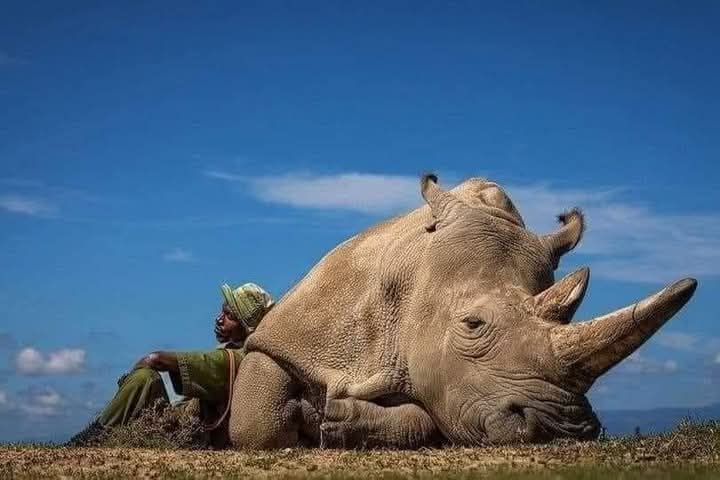The Tragic Tale of the Northern White Rhino: The Long Journey to Extinction
The Northern White Rhino, one of the world’s most majestic creatures, has become a poignant symbol of the devastating impact of human activities on wildlife. The news that this magnificent species is now officially extinct from planet Earth marks a sorrowful end to a long and storied history. It lived for 55 million years, surviving several ice ages, cataclysmic earthquakes, extinction events, and even meteor and asteroid strikes, only to be driven to extinction by the relatively recent actions of humankind. This tragedy shines a harsh light on the vulnerabilities of our planet’s most resilient species when faced with the pressures of human activity.

The History of a Majestic Species
The Northern White Rhino, scientifically known as Ceratotherium simum cottoni, once roamed vast areas of central and eastern Africa. For millions of years, this species adapted and thrived through epochs of dramatic environmental changes. During the ice ages, it endured harsh cold conditions and flourished when the Earth warmed again, its range expanding across savannas and open grasslands. It outlasted mass extinction events that wiped out countless other species, demonstrating resilience and adaptability that few animals could rival.
For eons, the Northern White Rhino was part of the Earth’s incredible biodiversity, contributing to the balance of ecosystems across the African continent. It coexisted with early humans, who viewed these colossal creatures with reverence and fear, but even as the human population expanded and became more adept at hunting, the Northern White Rhino endured.

The Decline Begins
As humans transitioned from being simple hunter-gatherers to forming complex societies and civilizations, the fate of the Northern White Rhino began to shift. The modern age saw the development of firearms, leading to mass hunting of wildlife, including rhinos, whose horns became prized commodities. Rhino horn was (and still is) believed to have medicinal properties in some cultures, especially in parts of Asia, and has also been sought after as a status symbol. The demand for rhino horn led to the widespread poaching of these animals, drastically reducing their populations in a matter of decades.
By the 20th century, the Northern White Rhino was already critically endangered, with only a few thousand individuals remaining. Habitat loss due to human expansion, agriculture, and deforestation further exacerbated the situation, as the areas where these rhinos could roam freely dwindled. Conservation efforts sprang up, but the momentum of decline proved difficult to reverse.

The Final Days
In the early 21st century, the world watched as the numbers of the Northern White Rhino continued to dwindle at an alarming rate. Conservationists raced against time, implementing measures like anti-poaching laws, protected reserves, and even armed guards for the few remaining rhinos. Despite these efforts, the population of Northern White Rhinos continued to fall victim to poachers, diseases, and the challenges of an ever-changing climate.
By 2018, only two known Northern White Rhinos remained on Earth, both of them female and unable to breed naturally. The last male, Sudan, had died earlier that year, marking the species’ virtual extinction. Scientists explored extraordinary measures, such as in-vitro fertilization using stored genetic material, to attempt to revive the species. However, these efforts have yet to yield successful results, and the chances of bringing back the Northern White Rhino remain incredibly slim.

The Role of Humans in the Extinction
The Northern White Rhino’s extinction is a sobering reminder of the influence humans have over the planet’s biodiversity. In only about 220,000 years since evolving as bipedal life forms, humans have not only mastered fire and tools but also developed the capacity to reshape entire ecosystems. Unfortunately, this power has often been used recklessly, with devastating consequences for countless species.
The Northern White Rhino’s downfall can be attributed directly to poaching and habitat destruction, both driven by human activity. The illegal wildlife trade, spurred by the desire for rhino horn, has been a major culprit in the near-total destruction of rhino populations across Africa. Additionally, the rapid expansion of human settlements and agriculture led to fragmentation and loss of habitats that these creatures relied on for survival.
A Reflection on Loss and the Way Forward
The extinction of the Northern White Rhino is not just a loss for Africa or conservationists—it is a loss for the entire planet and a stark indicator of the larger extinction crisis facing Earth’s biodiversity. The rhino’s story serves as a painful reminder that even the most resilient species, those that survive through multiple natural cataclysms, can fall prey to the unchecked actions of humanity.
While the loss of the Northern White Rhino is irreversible, it provides an opportunity for a more profound dialogue about wildlife conservation and the urgent need to protect the species still on the brink. Preventing the extinction of other species requires a combination of stringent anti-poaching measures, sustainable development practices, and public education about the importance of wildlife.
We are in the midst of what scientists term the “Sixth Mass Extinction,” where species are vanishing at an unprecedented rate. The extinction of the Northern White Rhino may well be a wake-up call for the need to reassess our relationship with nature. If the lessons of the Northern White Rhino’s extinction are heeded, it may help prevent similar tragedies in the future.
The tale of the Northern White Rhino is one of endurance against the odds, a creature that survived everything nature threw at it for millions of years, only to be undone by the consequences of human ambition and disregard. The extinction of this species stands as a haunting reminder that our actions have far-reaching impacts, and it is our responsibility to protect the richness and diversity of life on Earth for future generations.

Let the story of the Northern White Rhino resonate as a call to action, so that this tragic end will not be in vain, and that we may learn to live in harmony with the precious life that still surrounds us.



